

Cancer, Metabolism & Treatment
Progress in Cancer Treatment
“It takes more than one tool but many specialized tools to make a good sitting chair” In the same way of maintaining good health and treating chronic disease requires a “cocktail” of solutions to achieve a good functioning body.

Since the Yufoundation.org inception in 2006, we have grown, matured, and learned from others that we must continue our mitochondrial metabolic nutrition approach but incorporate, other modern technical tools such as balance human identical hormones, cleansing the body of accumulated toxic chemicals, to preserve, regenerate to maintain a good body homeostasis
The diagram above shows how we have incorporated modern good science with nutrition in the treatment for cancer. Alzheimer’s disease will be our next project. The new age of metabolic blocking agents as 3 Bromopyruvate, Dichloroacetate, Oxaloacetate can be used along with “repurposed drugs” such as anti-diabetes medication Metformin with anti-cancer effects, newer molecules such as Tyrosine kinase inhibitors, Check point inhibitor drugs and other targeted molecules have made big strides in controlling cancers and available for use.
In chemotherapy, the gradual change from “MTD maximum tolerated doses” of chemotherapy agents to a low dose (10% or less) constant “Metronomic chemotherapy” have avoided host bone marrow and immune suppression and yet effective to arrest the microenvironment of “Cancer environment such as angiogenesis” etc. The living but nonfunctioning “Senile cells” accumulation from 1 to 3 % in old and even younger people have led to research and development of senolytic molecules such as Quercetin and Fisetin and new drugs as a Dasatinib medication to remove these old useless cells and prevention of it converting to forms of chronic disease. These senile cells will secret SASP inflammatory chemicals, cytokines and proteases to promote changes to cancer and other dysfunctional cells.
While Yufoundation.org believe that CRONK calorie restricted optimal nutrition ketosis is the main practice to retard the aging process, we believe to address chronic diseases we must use a multi-prong cocktail approach as done with cure of tuberculosis and HIV diseases. CRONK has been around for over 100 years and it is known that even a 2-week practice of limiting calories to 1000 calories per day, 15,000 gene expression changes to a younger profile. CRONK promotes “Autophagy” can remove dysfunctional cells and maintain and repair important functional cells and organs. Because we live in a world today of, abundance of industrialized and refined foods such as sugar, starch, and processed oils such as trans fatty acids etc., a refrigerator with abundant food sources, we have become a rich society with increasing new diseases. Traditional religious practice for Catholics and Muslims have used fasting as a cleansing practice and today “Overnight fasting has become popular to induce ketosis in an overfed human being.
In our TOTT tripping over the truth conference in 2017 we focused on cancer and Alzheimer’s disease because we knew these 2 diseases had a similar metabolic defect.
In Alzheimer’s disease we know that the brain cells cannot utilize sugar as the main source of fuel because the mitochondrial enzymes are no longer able to metabolically use it efficiently which starts 10 years before clinical loss of memory, confirmed by radiological PET scan using FDG contrast.
In 90% of cancers its main source of fuel for survival is sugar, starch and glutamine amino acid and takes advantage of the modern food with an abundance of these simple sugars because its own cellular mitochondria organelle is defective. Cancer cells act like yeast and have an inefficient way of getting energy.
We know Caloric Restriction (CR) is associated with longevity (worms to primates and now human), but few are aware of the effects of CR on cancer growth. It retards cancer growth! Institutes such as Hippocrates Institute using raw foods and Kushi Institute using Macrobiotics have seen this effect for over 50 with up to 1000 guests per year.
Please watch the Please watch YouTube "George Yu and Starving Cancer Cells to Death" 2013 with details in Seminar section
Strict CR diet in human at 6 months Show Impressive Results
- 1200 to 1500 calories per day with nutritionally dense food that is easy to digest.
- Satiety from food combinations of texture, flavor, variety and volume
- Lose 10% of body weight
- Fasting blood sugar maintained between 80-90 mg/ dl. and high urine & Blood Ketones present
- Cancers atrophy or die while visceral fat decrease markedly "Visceral Defatting." Confirmed by CAT scans the body and PET scan show decline of sugar uptake plus biomarkers decline
- Cancer recurrence will occur when breaking from CR diet in the first 6- 10 months. Cancer remission occurs again with resumption of the diet.
- 1/3 will do very well (even cases of pancreatic cancer and metastatic malignant melanoma), but 2/3 will do well initially and then later they will fail.
- Long Term CR has problems. Short Term Cr is alternative.
One possible explanation is that cancer cells, unlike normal differentiated cells, utilize predominantly fermentation (like yeast) "glycolysis" for energy and less efficient use from their "Mitochondria" energy factories in the cells- cancers uses it poorly or not at all.
In fact, people who have active cancers who initiate a CR diet are "Starving Cancer Cells to Death".
PET scans
- Confirms an old concept "Warburg Effect". The analogue of sugar, 18F-flouro-2deoxy D glucose is what lights up in these scan showing high uptake of sugars in cancer cells.
- It seems that about 85% of all types of cancers have this characteristic.
- Cancer cells can use derive energy and ATP from glycolysis (60%) fermentation and an abnormal mitochondrial energy factories (40%) (Pederson and Ko).
2/3 of those who practice CR will eventually fail and they need more help. Why this occurs is unknown! However there might be an adaption of cancer cells to eventually use lactate and even ketones for energy however inefficient.
There are other ways to induce further destruction of cancer cell metabolism and not hurt normal cells of your body- metabolic blocking agents.
A sequential and systematic approach with CR first and then adding metabolic blockers will decreases the stress of sudden changes in the body (even massive cancer cell death "Tumor Lysis Syndrome") can disrupt normal body homeostasis) is probably the safest way of decreasing cancer load.
We believe people with cancer should first use:
- CR diets of 1200 to 1500 calories per day
- Use CR with ketogenic diet (high fat) or Ketone esters supplements as cancer cells do not utilize ketone as alternative fuel well at least initially.
- Consider anti-diabetic medications such as Metformin and herbs like Gymnema to lower blood sugar and insulin
- Consider additional metabolic blocking agents to prevent cancer cells from generating sufficient energy such as 3- Bromo Pyruvate , 2- deoxy Glucose, Dichloroacetate, etc. These molecules deprive abnormal cancer cells of energy or ATP and may leave normal functioning cells alone.
- There may be situations where traditional treatment such as surgical "Debulking", radiation and chemotherapy are implemented simultaneously. In fact, CR and partial "Fasting" makes the chemotherapy more effective in a study from Stanford University Medical Center (in bibliography).
History of the Science and the Human Experience
There are extensive basic science and emerging primate and human research confirming the longevity effects of caloric restriction with optimal nutrition ketosis, CRONK. What is less known is the attenuation effects of CRONK on cancer growth. Basic science research shows that the severity of CRONK, caloric restriction ketosis (20 to 60% of normal calorie intake) is positively correlated with lesser cancer growth. However eradicating all cancer growth using CRONK is more difficult. The bibliography provided in a separate section will have comprehensive references.
CRONK can vary in animal research defined as limiting caloric intake to 20-50%, however for human compliance in "real world scenarios"; nutritional institutes such as the CRONK society, Hippocrates Institute, Kushi Institute, Optimum Health Institute generally use a total of 1500 to 1800 Calories consumed by members per day and are tolerable and acceptable as long as there is sufficient volume, fiber, flavor and nutritional density and ease of digestibility.
Our foundation believes that cycling low calorie and then a period of higher calorie is the most realistic and acceptable way to do it. Modified "Fasting" with soups and juices are helpful for those who do not practice any CRONK.
Our foundation believes that cycling low calorie and then a period of higher calorie is the most realistic and acceptable way to do it. MF, Modified Fasting with soups and juices are helpful for those who do not practice any CRONK.
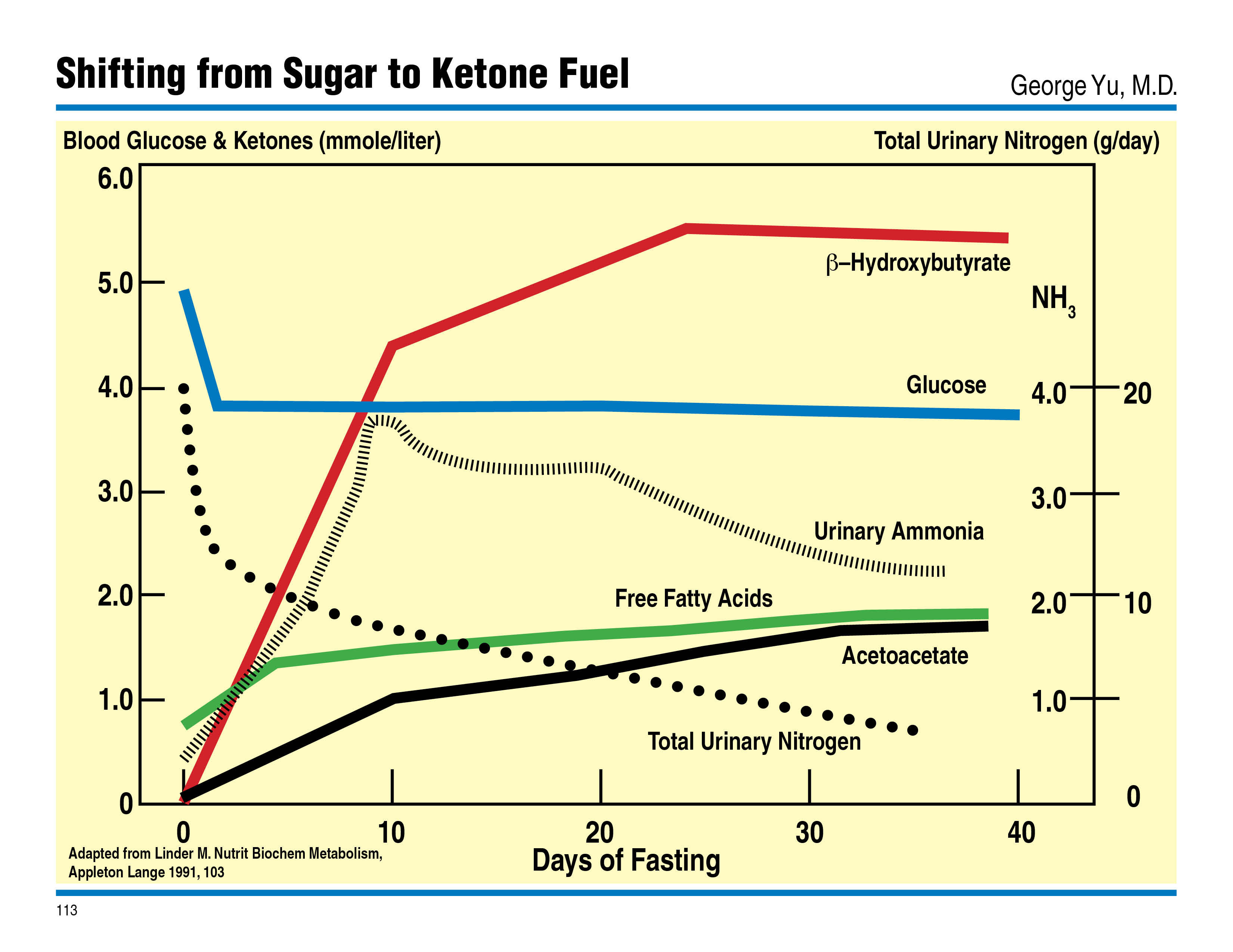
The first human study Biosphere 2 in 1989 isolated eight (8) men and women in a self-contained 4000 square feet sphere for 2 years and all their risk factors for modern diseases decreased such as serum Insulin, glucose, lipids and blood pressures etc. in all eight individuals. This is probably one of the most expensive studies ever done as a preparation for human experience in outer space funded by a visionary billionaire Ed Bass of Texas.
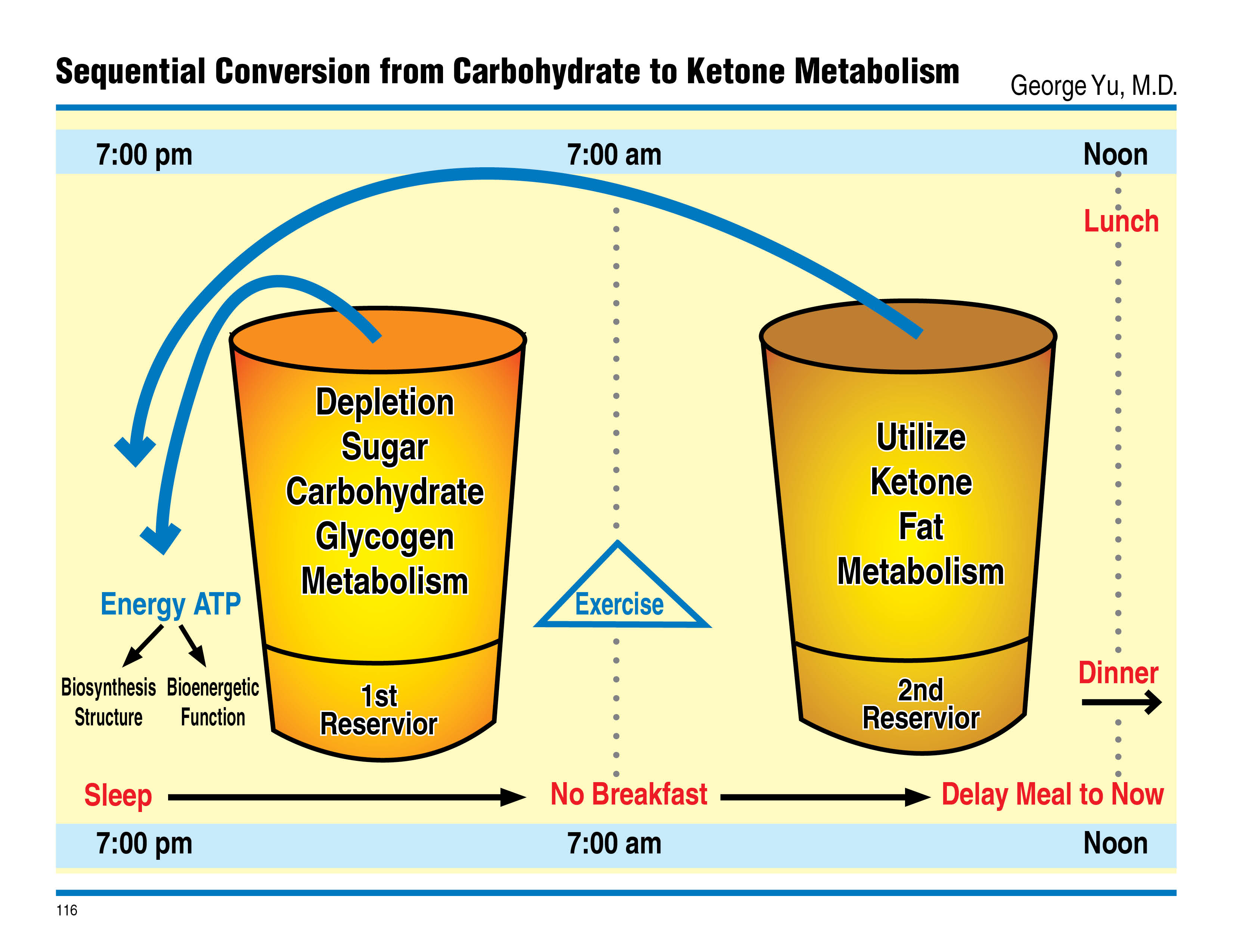
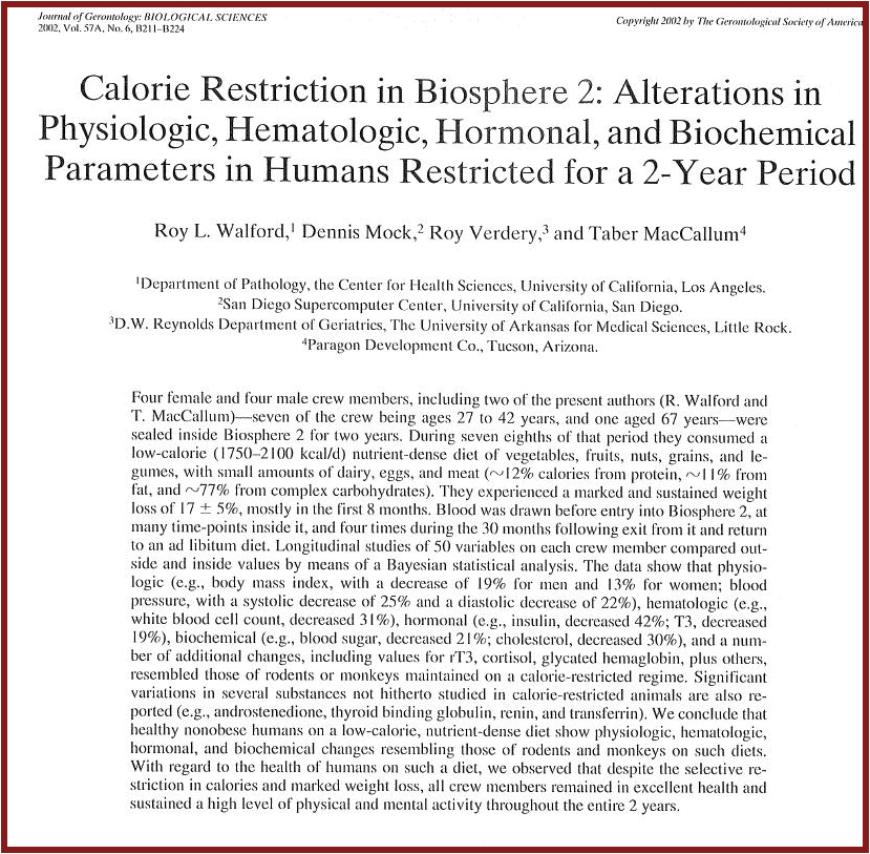
There are institutions worldwide that practice CRONK with members eating a variety of foods from raw vegetable food, cooked vegetable-based foods with minimal animal protein (fish, eggs) and use simple and easily digestible foods with the aids of probiotics and digestive enzymes for efficient food breakdown and digestion. All the practices have a common feature- the total calories consumed per day is around 1500 to 1800 calories. These institutions have an average of 1000 new visitors yearly and the guests stay for 3-5 weeks to accustom themselves to the diet and learn food preparations upon departure. I have been privileged to perform audits on some of the organizations and have witnessed their practices and outcomes.
Dr. George Yu, M.D. - Personal Clinical Experience CRONK effect on Human Cancers Through the Hippocrates and Kushi Institutes and the Caloric Restriction Association
At George Washington University Medical Center and Anne Arundel Medical Center, I have been urological surgical oncologist and reconstructive surgeon for thirty five (35) years and worked as part of the team of medical oncologists, radiation oncologists in designing treatment plans for patients with advanced metastatic cancers. My area of interest has been on the biology of invasive bladder cancers and treatments including surgery, chemotherapy, radiation and CRONK.

A remarkable turn of events for me occurred in 1999 when I volunteered to act as an "auditor" for CAM (Complementary Alternative Medicine) for the "best case analysis" program at National Institute of Health on nutritional interventions in terminal cancer patients with widespread disease. Specifically, working with the Kushi Institute using a "macrobiotic" diet (nutritional dense but caloric limited foods), I audited over 300 cases of people with a variety of primary cancers and usually with metastatic disease. Among cancers studied were people with pancreatic, melanoma, lung, lymphoma, breast cancers all with widespread metastasis who survived and some were cured using nutrition after conventional treatment failures. Dr. Larry Kushi, professor of Epidemiology formally at Columbia University and at present with the Kaiser Institute in California had initially reviewed these original cases as part of a study on nutrition and chronic disease.

After the formal presentation on February 25, 2002 at the NIH with fifteen (15) reviewers who all confirmed positive results from diet alone, I continued to pursue further audits with institutions such as Hippocrates Institute in Florida. Their practice differed in their use of raw vegetable foods (no fruits, no sugar, and no dairy) with similar nutritionally dense but caloric restricted diets and found consistently similar results.

Photo: CRONK diet raw food hypocrites institute
If I did not personally review these medical data charts, see the survivors and failures, consume their foods, I would never have believed or accepted that CRONK nutritional intervention could show such impressive effects on chronic cancerous diseases. People who practice CRONK are content and satisfied using low calorie diets as there is variety. What is consistent after eating CRONK diet regimen for longer than 48 hours is that the hunger sensation diminishes markedly even for people who eat diets with calories up to 3000 per day normally.
Most researchers of "Caloric Restriction Optimal Nutrition Ketosis" CRONK do not believe that it is possible for humans to consume 1500 - 1800 calories per day and feel satisfied because they have rarely experienced it themselves.
Around 2001, the publication by Stephen Spindler’s research team at University of California Riverside showed that 70% of gene expression changed dramatically within 4 weeks of CRONK diets in animal studies suggesting that STCR (Short Term Caloric Restriction) replicated the effects of LTCR (Long Term Caloric Restriction) quickly. The implication is that human and animal genotype responded to external stimulus and adjusted rapidly by modulating gene expressions. This was a critical concept as long-term CRONK has long- term adverse effects and as clinicians if we could "cycle on and off periods" of very strict CRONK and modest increase in the off periods the patient compliance is acceptable and realistic!
Cao, S. X. Dhahbi, J.M., Mote, P.L. & Spindler, S. R. Genomic profiling of short- and long-term caloric restriction effects in the liver of aging mice. (2001) Proc. Natl. Acad. Sci. U.S.A. 98, 10630-10635.
What Did We Learn from monitoring CR cancer patients in 13 years. CRONK + Moderate Ketosis
- All groups practice a form of CRONK "Caloric Restriction Optimal Nutrition Ketosis" limiting total intake of 1500- 1800 calories per day but the food was nutritionally dense and free from sugars, no fruits and diaries. Fruits have a special consideration because of its high Fructose content. The data from the administrators of these institutions and my own corroboration in past 13 years show that approximately 1/3 of the cases have impressive regression of cancers and some go into complete remission but 2/3 of them will improve both from objective studies (CAT scans + blood markers), physical examination and symptoms relief but later, developed a recurrence and die. At that point using CR diet will not stop progression of cancers.
- The CAT scans uniformly showed shrinkage of tumors within 3-6 months while the "visceral defatting" (intra-abdominal visceral fat or "Apple Belly") all shrunk completely.
- The patients lost 10% of their body weight.
- Blood sugars 70 to 85 mg/dl and ketones are present in their urine. Some patients examined have blood ketones up to 5 mmol.
- Blood Insulin levels is between 5- 8 micro international units/ml
- Hemoglobin A1C is 5 to 5.5%
- The PET/CAT fused scans, using a glucose analogue 18F-flouro-2deoxyD glucose (FDG) showed improvement with less cancer uptake of sugar after going on a CRONK diet.
- Cancer recurrence will occur if they return to an unrestricted diet and will also regress if resuming a strict CRONK diet.
- CR has negative effects such as bone and muscle loss and hormone dysregulations on long term use. We cycle CRONK as Short Term CR as noted above.
As noted above, the majority or 2/3 of patients on Caloric Restriction will first respond and later progress, fail and finally die, therefore we need additional adjunctive treatments to improve their survival. How another version of Caloric Restricted Diet with a Ketotic component will fair is yet to be seen but promising as noted above in NIH supported trials.
I believe these cases all had one common feature: these aggressive solid tumor cancers depended on an inefficient metabolism, glycolysis and partly on oxidative phosphorylation, and in layman’s term limiting calories in their diet was a form of "starvation" of cancers.
CRONK diets leads to moderate Ketosis, a metabolic evolutionary adaptation to low calories and we term this CRONK. CRONK ketogenic diet is low calories with additional use of ketone producing foods or supplements. We use Caprylic Acid (Carbon 8 medium chain fatty acids) with the CRONK diets to enhance ketogenic effect without resorting to foods which are difficult to digest.
As James Watson, the Nobel Prize winner defining the structure of DNA emphasized in a lecture at Yale University in 2012 - "Glycolysis is perhaps the Achilles Heel of Cancer Cells."
After observing and practicing CR in our oncological patients for over thirteen (13) years, I am convinced of the importance of Caloric Restriction and or Caloric restricted with a Ketogenic component in retarding aggressive cancer growths. These findings are consistent with the concept that most cancers predominately have a defective metabolism with a predominance of cell glycolysis (Warburg Effect) and a Hexokinase 2 defect of the mitochondria as described by Pedersen and Ko. This may the reason why some of these CR diets had such a profound effect on their cancer growths. Yet only the minority has permanent results and the majority will respond but eventually fail but we do not know why certain individuals respond and others do not.
Ketogenic Diets with Caloric Restriction
The ketogenic diet (a high fat diet) yet low calories used to treat childhood epilepsy are well known to be effective and safe. This old regimen was further developed and popularized at Johns Hopkins by the late Dr. John Freeman and associates. As simple CR diets (without the ketogenic part) often will show "ketosis" as a body adaptation to scares calories intake, the concept of using ketones derived from oils may also lead to a further insult to cancer cells but not to normal body tissue cell metabolism.
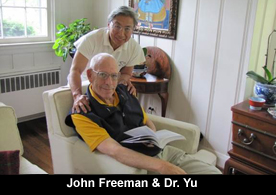
In the nutritional and metabolic approach to cancer arrest, we can use the traditional CR diets as practiced by the above institutions but also the alternative of a high fat ketogenic diet with caloric restriction as two arms of the nutritional approach to cancer eradication. The CR with ketogenic component is especially effective in brain cancers such as Glioblastoma M.
Research and Metabolic Strategy to Arrest Cancer Growth by Decreasing Supply of Glucose, Arresting Full ATP Energy Production, Mitochondrial Disruption, Electron Transfer Dysfunction of Mitochondria etc.
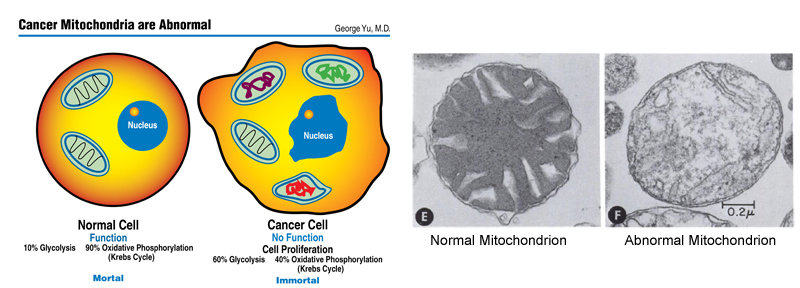
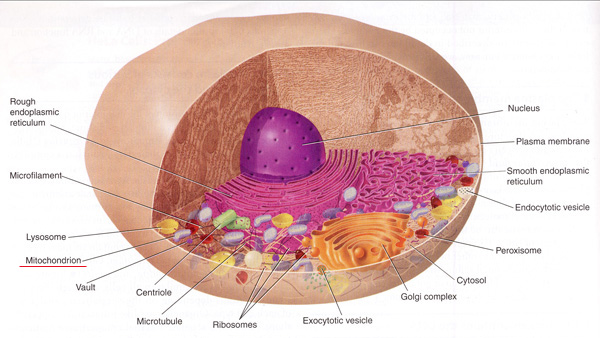
There is accumulated evidence from basic science research showing that most cancer cells use predominately glycolysis (fermentation) energy, but have a defective production of energy from the mitochondria or in other words "unable to utilize oxidative phosphorylation (Krebs Cycle) efficiently".

The basic science research has already been done by many researchers summarized in the recent publication 2012 by Thomas Seyfried Cancer as a Metabolic Disease confirming the "Warburg Effect" for most cancers. This is an excellent summary of all the research and experience worldwide and recommends all to read it.

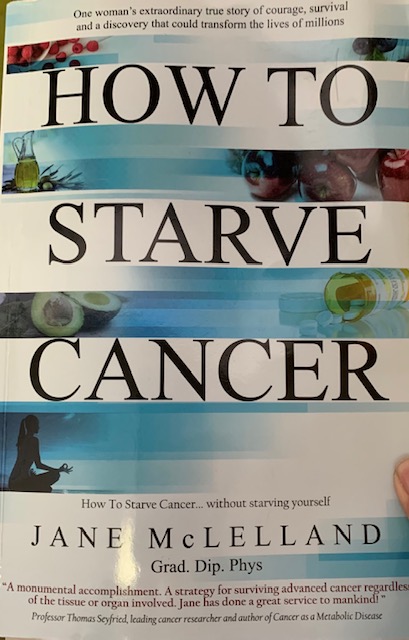
PET/CAT fused scans using FDG 18F-flouro-2deoxyDglucose uptake in cancer cells are an important diagnostic and prognostic tools and the basis of this study is the "glycolytic" nature of cancerous cells.
“As respiration is responsible for maintaining genomic stability and the differentiated state, respiratory insufficiency will eventually induce the default state of unbridled proliferation.” ~ Thomas N. Seyfried Cancer as a Metabolic Disease page 235
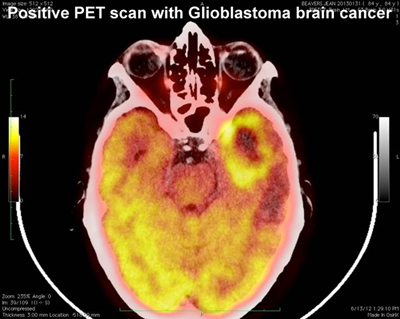
There are many basic researchers and clinicians who are actively pursuing the metabolic approach to cancer disease. The goal is to destroy cancer cells while preserving normal cells.
- The research done by Pamela Goodwin of University of Toronto leading a 3500 breast cancer patient study on the use of Metformin (diabetic medication to lower blood sugar and insulin) and its positive effect on patients with cancers suggests again a metabolic effect on cancers.
- Thomas Seyfried of Boston College is a basic scientist who has been instrumental in pushing this concept for so long and wrote a comprehensive document, Cancer As A Metabolic Disease 2012.
- Peter Pedersen of Johns Hopkins and Young Ko isolated a Hexokinase 2 in cancer cells and the use of a unique molecule 3BrPA, 3 Bromo Pyruvate, which blocks cancer ATP production while causing no harm to normal cells. Dr. Pedersen continued to champion research on cancer metabolism and was instrumental in the development of the clinical use of PET/CAT fused scans for cancer diagnostics.
- Clinicians such as neurosurgeon Joseph Maroon of University of Pittsburg has been focusing on eradicating brain tumor Glioblastoma and the use of caloric restricted ketogenic diet.
- In the clinical nutritional field there are organizations such Ketogenic Therapies and the "Charlie Foundation" with Beth Zupec-Kania who used a similar ketogenic diet (treatment for childhood epilepsy) on Glioblastoma cancer patients and have seen dramatic responses.
- Most cancers will show glucose uptakes but interestingly, breast and prostate cancers are hormonally dependent but only breast cancers show early uptake whereas prostate cancers with a slow doubling time of 300 - 500 days do not show uptake till a later stage when the cancer becomes more progressive and aggressive. Prostate cancer has its own unique ability to utilize citrate in its adaptation to getting its energy via mitochondrial oxidative phosphorylation by blocking zinc ZIP membrane transporter (ref. Costello Les C). Our overemphasis on hormonal aspects of prostate cancer has overshadowed this important constant finding. In the future our foundation will support this aspect of prostate cancer metabolism for treatment and prevention.
- Another basic scientist Dominic D'Agostino of University of South Florida has been working on animal models with ketogenic diets plus use of ketone salts and esters plus the use of hyperbaric chambers.
- My colleague Richard Veech of NIH and Karien Clarke of Cambridge University has developed liquid ketone esters.
- Dr. Merrill Garnett (Garnett Mckeen laboratory) who tested 30,000 chemicals and found Palladium alpha Lipoic acid to disrupt cancer cell metabolism within the electron transfer system for energy generation in cancer cells while protecting normal cells.
- Worldwide there are researchers such as Mark Coster's team of Griffith University in Australia who are selectively targeting cancers' mitochondria with an analogue of Vitamin E.
- Chris Proud's team at University of Southampton, UK have isolated eFF2K which allows cancer cells to survive despite starvation- therefore blocking this molecule kills the cancer cells without harming normal cells.


Research work by Peter Pedersen at Johns Hopkins and Young Ko at University of Maryland, my close associates, show that it may be the cancers derive 60% of energy from glycolysis and up to 40% from an inefficient form of oxidative phosphorylation. In essence cancers may start as a metabolic disease but whether it is from a mitochondrial DNA mutation is unclear. Initiating from the defective metabolism in cancer cells, secondary DNA instability and mutations can take place. The elegant discussion by Drs. Pedersen and Ko below elaborates in detail the rationale of the "Warburg Theory" and their discovery of 3-bromo pyruvate, 3-BrPA. Pedersen and Ko describe 3-BrPA as a potent inhibitor of all ATP production from glycolysis and oxidative phosphorylation in cancerous cells.
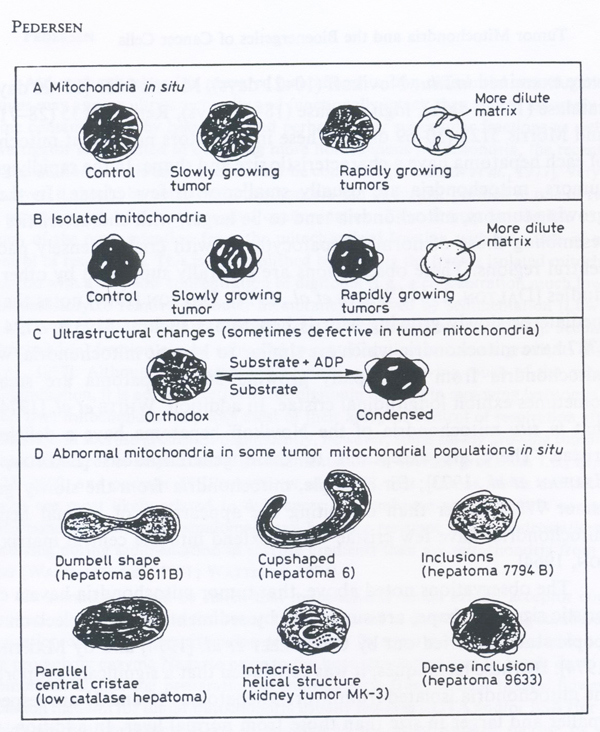
NCI and NIH Mitochondria Interest Group Seminar: Johns Hopkins' Pedersen Addresses Role of Mitochondria in Cancer
https://videocast.nih.gov/summary.asp?live=7542
Pressing Need to Use Caloric Restriction and Adjunctive Agents with Efficacy but Minimum Adverse Effects
The National Cancer Institute 60 Human Cell Lines Screening
National Cancer Institute 60 human cancer cell lines screening with 3 Bromo Pyruvate. May 18 2015 shows promise in human cancer cell deaths using this metabolic agent.
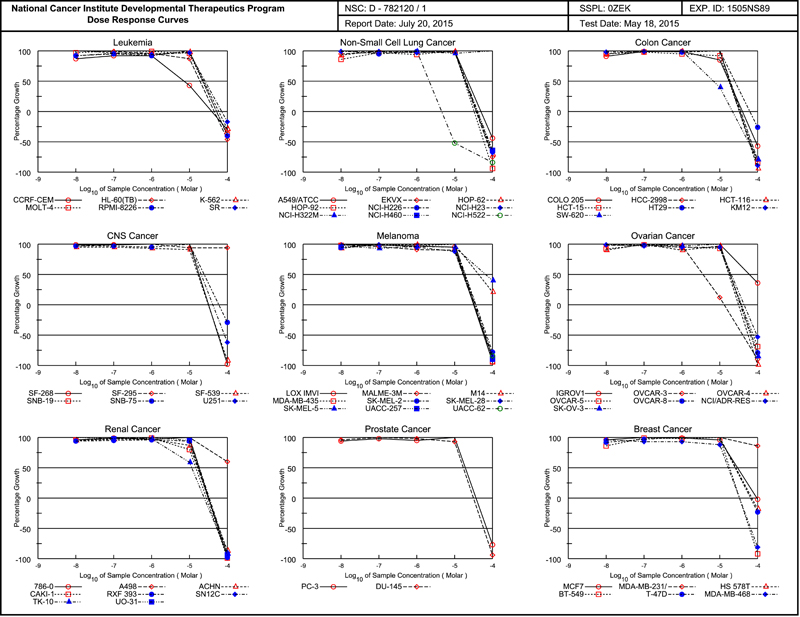
The use of 3 Bromo Pyruvate, 2-Deoxyglucose, Dichloroacetate are among the few of the interesting molecules which may inhibit glycolysis and mitochondrial functions, which may be an important class of chemicals which may enhance the effects of CRONK "Caloric Restriction Optimal Nutrition Ketosis" as a more complete the metabolic approach to cancer eradication.